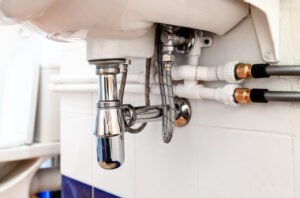
Blog
How to Connect Pipes Under a Sink: A Comprehensive Guide
Connecting pipes under a sink might seem like a daunting task, but with the right tools and a bit of patience, it can be a straightforward DIY project. Whether you’re installing a new sink or replacing old plumbing, this guide will walk you through the process step-by-step.
Tools and Materials You’ll Need
Before you start, gather the following tools and materials:
- Pipe wrench
- Plumber’s tape (Teflon tape)
- PVC or metal piping
- Pipe cutter or hacksaw
- Adjustable wrench
- Bucket (to catch any water)
- Towels or rags
Step-by-Step Instructions
Turn Off the Water Supply
Locate the shut-off valves under the sink and turn them clockwise to close. If there are no shut-off valves, you may need to turn off the main water supply to your home.
Remove the Old Pipes
Place a bucket under the sink to catch any residual water. Use a pipe wrench to loosen the nuts connecting the old pipes. Carefully remove the pipes and clean the area of any debris or old plumber’s tape.
Measure and Cut New Pipes
Measure the distance between the sink drain and the wall drainpipe. Cut the new pipes to the appropriate length using a pipe cutter or hacksaw. Ensure the cuts are straight and smooth to prevent leaks.
Dry Fit the Pipes
Before applying any plumber’s tape or cement, dry fit the pipes to ensure they fit correctly. This step helps you make any necessary adjustments before finalizing the connections.
Apply Plumber’s Tape
Wrap plumber’s tape around the threads of the pipes. This tape helps create a watertight seal and prevents leaks. Wrap the tape clockwise around the threads three to four times.
Connect the Pipes
Start by connecting the tailpiece to the sink drain. Tighten the nut by hand, then use an adjustable wrench to secure it further. Next, connect the P-trap to the tailpiece and the wall drainpipe. Ensure all connections are tight but avoid over-tightening, which can damage the pipes.
Secure the Connections
Once all the pipes are connected, use a pipe wrench to ensure all nuts are securely tightened. Check that the pipes are aligned correctly and that there are no gaps or misalignments.
Test for Leaks
Turn the water supply back on and let the water run for a few minutes. Check all connections for leaks. If you notice any leaks, tighten the connections further or reapply plumber’s tape as needed.
Final Adjustments
If everything is working correctly, make any final adjustments to ensure the pipes are secure and properly aligned. Clean up any water spills and dispose of the old pipes and debris.
Tips for Success
- Take Your Time: Rushing through the process can lead to mistakes and potential leaks. Take your time to ensure each step is done correctly.
- Use Quality Materials: Invest in high-quality pipes and fittings to ensure the longevity of your plumbing.
- Seek Help if Needed: If you encounter any issues or feel unsure about any step, don’t hesitate to seek help from a professional plumber.
Conclusion
Unblocking an outdoor drain is a manageable task with the right approach and tools. By following these steps, you can keep your drains clear and prevent future blockages. Regular maintenance and preventive measures will help ensure your outdoor drains remain free-flowing and efficient
Most Popular

How to Connect Pipes Under a Sink: A Comprehensive Guide
Blog Connecting pipes under a sink might seem like a daunting task, but with the right tools and a bit

How to Unblock Outdoor Drains: A Comprehensive Guide
Blog Blocked outdoor drains can be a nuisance, causing water to pool and potentially leading to unpleasant odors and even

How to Stop a Running Toilet: A Comprehensive Guide
Blog A running toilet can be more than just an annoying sound in your home; it can also lead to

